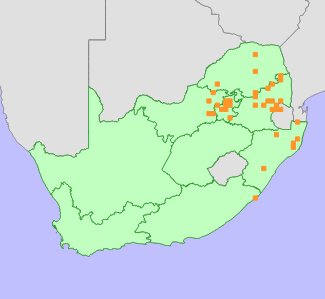| Scientific Name | Ceropegia rendallii N.E.Br. | Higher Classification | Dicotyledons | Family | APOCYNACEAE |
National Status | Status and Criteria | Least Concern | Assessment Date | 2020/02/18 | Assessor(s) | L. von Staden | Justification | Ceropegia rendallii is widespread and not in danger of extinction. |
Distribution | Endemism | Not endemic to South Africa | Provincial distribution | Eastern Cape, Free State, Gauteng, KwaZulu-Natal, Limpopo, North West | Range | This species is widespread across northern and eastern South Africa, from Potchefstroom and the Waterberg to the Mpumalanga Lowveld, with isolated occurrences in Zululand and KwaZulu-Natal south coast. It also occurs in eSwatini (Swaziland). |
Habitat and Ecology | Major system | Terrestrial | Major habitats | Woodbush Granite Grassland, Carletonville Dolomite Grassland, Waterberg Mountain Bushveld, Central Sandy Bushveld, Andesite Mountain Bushveld, Gauteng Shale Mountain Bushveld, KwaZulu-Natal Highland Thornveld, Mamabolo Mountain Bushveld, Waterberg-Magaliesberg Summit Sourveld, Ohrigstad Mountain Bushveld, Northern Escarpment Quartzite Sourveld, Northern Escarpment Dolomite Grassland, Sekhukhune Montane Grassland, KaNgwane Montane Grassland, Eastern Highveld Grassland, Egoli Granite Grassland, Ithala Quartzite Sourveld, Western Maputaland Sandy Bushveld, KwaZulu-Natal Hinterland Thornveld, Legogote Sour Bushveld, Granite Lowveld, Crocodile Gorge Mountain Bushveld, Zululand Coastal Thornveld, Zululand Lowveld, Soutpansberg Mountain Bushveld, Western Maputaland Clay Bushveld, Eastern Valley Bushveld, Tembe Sandy Bushveld, Swaziland Sour Bushveld, Kaalrug Mountain Bushveld, Malelane Mountain Bushveld, Gold Reef Mountain Bushveld, Sekhukhune Mountain Bushveld, Makatini Clay Thicket | Description | It occurs on rocky outcrops in bushveld and grassland. |
Population | Population trend | Stable |
Assessment History |
Taxon assessed |
Status and Criteria |
Citation/Red List version | | Ceropegia rendallii N.E.Br. | Least Concern | Raimondo et al. (2009) | | Ceropegia rendallii N.E.Br. | Lower Risk - Least Concern | Scott-Shaw (1999) | |
Bibliography | Dyer, R.A. 1980. Brachystelma, Ceropegia and Riocreuxia. In: O.A. Leistner (ed). Flora of Southern Africa 27 Part 4:1-88. Botanical Research Institute, Pretoria.
Dyer, R.A. 1983. Ceropegia, Brachystelma and Riocreuxia in southern Africa. A.A. Balkema, Rotterdam, Netherlands.
Raimondo, D., von Staden, L., Foden, W., Victor, J.E., Helme, N.A., Turner, R.C., Kamundi, D.A. and Manyama, P.A. 2009. Red List of South African Plants. Strelitzia 25. South African National Biodiversity Institute, Pretoria.
Scott-Shaw, C.R. 1999. Rare and threatened plants of KwaZulu-Natal and neighbouring regions. KwaZulu-Natal Nature Conservation Service, Pietermaritzburg.
|
Citation | | von Staden, L. 2020. Ceropegia rendallii N.E.Br. National Assessment: Red List of South African Plants version . Accessed on 2025/04/18 |
 Comment on this assessment Comment on this assessment
|
Search for images of Ceropegia rendallii on iNaturalist
|
 Comment on this assessment
Comment on this assessment


